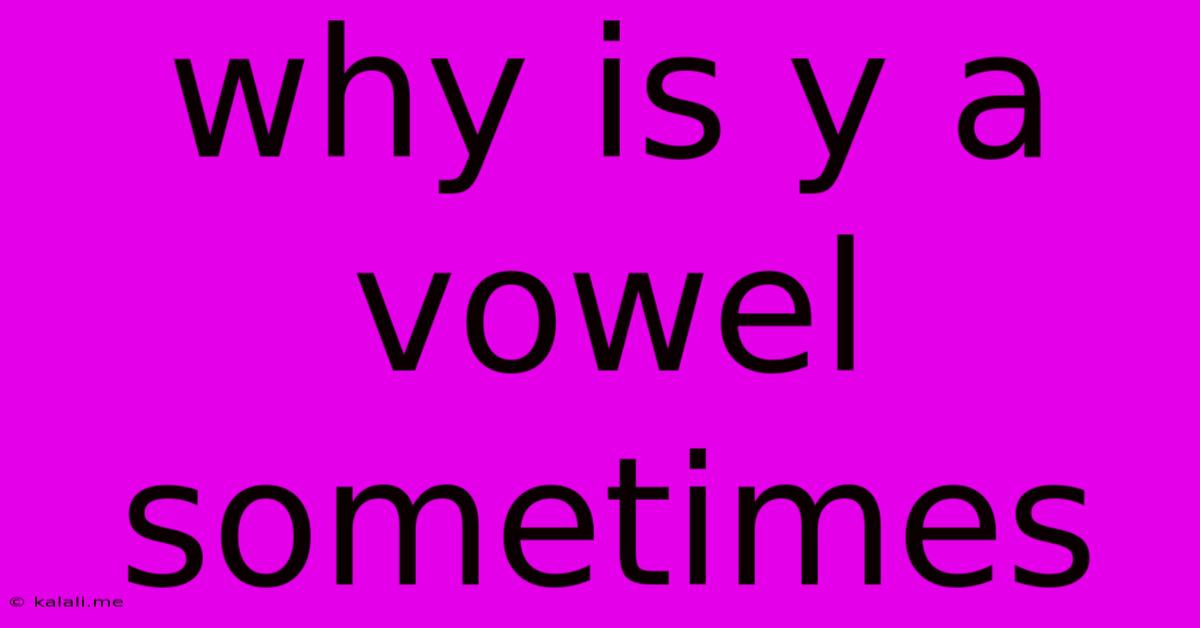Why Is Y A Vowel Sometimes
Kalali
Jun 09, 2025 · 3 min read

Table of Contents
Why Is Y Sometimes a Vowel? The Curious Case of the Semi-Vowel
The English language, a glorious melting pot of linguistic influences, often throws curveballs. One such curveball? The letter "y". Sometimes a consonant, sometimes a vowel – its dual nature often leaves learners scratching their heads. Understanding why hinges on understanding its phonetic function within a word, not simply its alphabetical position. This article will delve into the fascinating linguistic reasons behind Y's chameleon-like behavior.
Why does Y sometimes act like a vowel and other times like a consonant? It's all about its sound and its position in a word. Let's break it down.
Y as a Consonant
Most often, you'll encounter "y" acting as a consonant. Think of words like "yellow," "year," and "yoyo." In these instances, "y" produces a consonant sound, typically a /j/ sound (as in "yes"). The sound is produced by the tongue making contact with the roof of the mouth, a characteristic of consonants. Its sound is similar to the "y" in "yes", acting as a consonant at the start of the word.
The letter 'y' acts as a consonant when it:
- Starts a word: Examples include "yacht," "yawn," and "young."
- Follows a consonant: Consider the words "rhythm" and "beyond," where "y" plays a purely consonantal role.
Y as a Vowel
Now, here's where things get interesting. "Y" takes on a vocalic role when it functions as the main vowel sound in a syllable. This often happens at the end of a word or in the middle of a word, but after a consonant. The key is how the sound is made. Vowel sounds are produced with open vocal tracts, allowing air to flow freely. In these positions, 'y' creates a vowel sound, most often an /i/ sound (as in "see") or /ai/ sound (as in "my").
Here's when "y" behaves as a vowel:
- At the end of a word: In words like "happy," "cry," and "sky," "y" forms the final vowel sound.
- In the middle of a word: Consider words like "mystery," "system," or "day." The "y" acts as the vowel sound in those syllables.
- Creating diphthongs: In words like "boy" and "joy," the "y" combines with another vowel to form a diphthong (a vowel sound that shifts during pronunciation).
Understanding the Nuances
The distinction between "y" as a consonant and a vowel comes down to its phonetic function within a specific word and its position within that word. It's not about a strict grammatical rule but about the sound it creates. Think about pronunciation, not just spelling.
In short: While the alphabet classifies "y" as a consonant, its phonetic behavior can be both consonantal and vocalic, depending on its context. This linguistic flexibility is part of what makes the English language so vibrant yet complex.
By understanding this nuanced behavior, you can better grasp the intricacies of English pronunciation and improve your overall comprehension of the language. Remember to always consider the sound a letter makes rather than solely its alphabetical classification.
Latest Posts
Latest Posts
-
How Long Ago Was The 16th Century
Jul 01, 2025
-
How Many Inches Are In 4 Yards
Jul 01, 2025
-
How Many Calories In A Pound Of Hamburger
Jul 01, 2025
-
How Many Ounces Are In 9 Pounds
Jul 01, 2025
-
What Kind Of Room Has No Doors Or Windows
Jul 01, 2025
Related Post
Thank you for visiting our website which covers about Why Is Y A Vowel Sometimes . We hope the information provided has been useful to you. Feel free to contact us if you have any questions or need further assistance. See you next time and don't miss to bookmark.